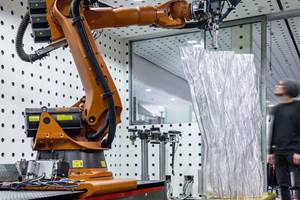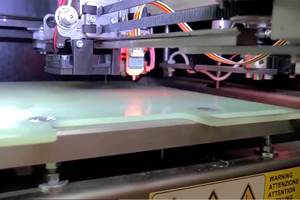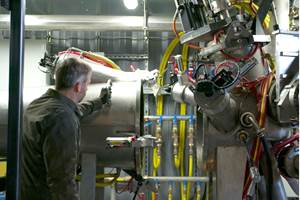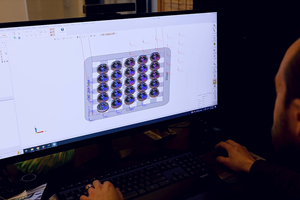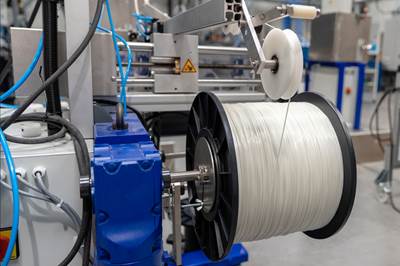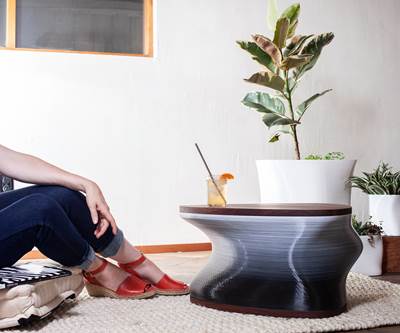Share
Read Next
When we first covered Model No. in 2020, the company was manufacturing furniture on its own large-format 3D printers, built to designs directly manipulated by customers through parametric options available on its website. Four years later, production looks a bit different. Gone is the user-facing design tool, as the company has discovered that conversation with customers is the more effective way to arrive at the right designs for its clients. More colors and materials are offered today, in part because of a circular economy-focused project that Model No. completed with several partners. And there’s one important change to how furniture is made — listen to the episode to learn how (and why) the company’s 3D printing capacity has evolved in the last few years.
Transcript
Peter Zelinski 00:06
Sustainable customizable furniture made with large format 3D printing. We are revisiting the subject of some past reporting in today's episode as Stephanie Hendrixson gives us the update on furniture maker Model No. in this episode of AM Radio.
Jodee McElfresh 00:30
AM Radio is a product of Additive Manufacturing Media. So are The Cool Parts Show, The Buildup and Additive Manufacturing Magazine. Ready to be a part of the AMuniverse? Subscribe at AdditiveManufacturing.Media today.
Peter Zelinski 00:47
Welcome to AM Radio. I'm Pete Zelinski joined in the studio today by Stephanie Hendrixson. Hi, Stephanie.
Stephanie Hendrixson 00:52
Hi, Pete.
Peter Zelinski 00:53
So Stephanie, there is this company that I really like, even though everything I know about them is from you the company's model number they're a furniture maker. You reported on them originally in 2020, I believe. And I understand you've talked to them again more recently. And they've changed a little bit.
Stephanie Hendrixson 01:14
Yeah, that's right. So original story about model number appeared in 2020. This is like one of the interviews I was doing remotely because we were all at home. But more recently, I heard from this company again, and had kind of a follow up conversation and learned about a lot of things actually that have changed in the last four years.
Peter Zelinski 01:33
Here's what I recall, model number. They make furniture, they're based in Oakland, California, there are various processes that go into making their furniture, not just 3D printing, but they rely extensively on 3D printing. And what the company name has to do with is the way that there is so much customization possible on the consumer end that a model number for a given order could refer to a unique piece of furniture because of all the parametric design choices that a buyer had made. And 3D printing is significant to realizing a lot of these customized geometric features. To the extent they had developed their own large-format 3D printers. And there's this concept that we much later identified and came to talk about, the idea of the AMfactory, the additive manufacturing technology developer that does not sell the technology itself, but instead puts it to use in their own factory, their own facility and, and Model No. at least back then seem to be an example of that. And there's a circular economy aspect of what they're doing to because in their 3D printing, they were relying on plant-based PLA rather than petroleum based polymers. So I think there's a lot more I could say about what's interesting about model number, but that's sort of the bones of what I remember about them and, and we haven't heard from them in quite a while. So where are they now?
Stephanie Hendrixson 03:05
So I think that's a pretty good summary. And I have updates about almost everything that you mentioned. So back in 2020, I spoke with Jeffrey McGrew and Jillian Northrup, they are cofounders there. There are three cofounders in total of Model No. And we talked about all the different things that you mentioned, in this most recent conversation, I spoke with Phillip Raub, who's the CEO of Model No., he joined the company in 2020, that same year, and there was somebody else on our call too, but I'll hold that for now. But what I learned from Phillip is that there's a lot of ways that Model No. and the way that they think about furniture and their role as a furniture manufacturer, a lot of ways that that has evolved. So you mentioned customer customization, like this idea that you could go on their website at the time and pull up basic design for a table or a chair or a stool. And then you would be presented with all of these different options. So things that you could get from other furniture stores, like choosing the color, choosing the type of wood that's going to be the tabletop, those sorts of things were there. But along with that, they had also put a lot of work into these customer-facing parametric design tools. And so you'd be presented with all of these different sliders to change maybe the height of the table, the the width of the base, if there was any sort of like, twist to it or other features, you might have options to adjust it. And that was sort of the differentiator at the time, like a way to get really interesting, customized furniture that's exactly going to fit your space, it's going to be exactly what you want. And that's still what they're doing. But as Phillip had told me, they've taken that parametric design tool off of their website, they found that lots of people were playing with it, like they would go online and just, you know, tweak the furniture and see what it looked like. But people weren't necessarily ordering based on that. And so he told me, you know, customization is still core to what the company does and what they want to be doing. But instead of that sort of direct to consumer approach, now the customization is happening through conversations with customers, and the customer base has changed also. So we're previously they thought a lot of this demand was going to come from individuals and like residential applications, there are still people out there that are ordering this furniture in that way. But more of their business is made up of commercial clients. And so there are companies like hotel chains or corporations that want to furnish their headquarters with a unique set of furniture that are coming to them. And working with Model No. kind of hand-in-hand to design exactly the thing that they want. It's just, they're still customizing, it's just happening in a different way.
Peter Zelinski 05:34
Now, I am really interested in customization through the consumer-facing parametric digital interface and the perils of that, that they discovered, I could really see that part of the consumer satisfaction would end up getting satisfied just by manipulating and creating the furniture virtually that they wouldn't have to go all the way through and make a sale. Yeah, who really, really needs custom furniture? It is larger enterprises wanting to solve very specific furnishing related challenges at scale, like this makes a whole lot of sense. And then for a buyer like that the conversation is the much more efficient way to go for everybody. So it sounds like they had the right idea for the right kind of customizable furniture product. It's just who exactly would want it and how best to deliver the customization experience. Yes. So this is a customer experience customer facing type change. But that's still a big change from where they were.
Stephanie Hendrixson 06:43
Yeah. And I think you know, it's shifting the work of the designer back to their professional team of designers. I think there are people that would like the ability to go on and tweak their furniture and order exactly the size table that they want. But they're just finding that that proved to be kind of a barrier. I remember talking back in 2020, like they really made efforts to reduce the number of choices like not give you tons and tons of sliders. And of course there were like minimum and maximum values that would ensure that your furniture could still be printed and produced. But even that was kind of overwhelming. Phillip likened it to, it's kind of like being asked to build your own car. Like we expect certain options, like certain trim choices when we when we buy a new car, but we don't want to build the whole thing from the ground up.
Peter Zelinski 07:27
That's a good point.
Stephanie Hendrixson 07:28
So another thing that's different in 2024, you mentioned their circular economy and sustainability efforts. Back when I spoke to them in 2020, Model No. was doing some research into how to recycle that PLA that they were using, how do you grind it up? Put it back into a 3D printer? And is the material quality going to be the same? Or how does it change as you continue to reuse it? They've gone further with that idea. The reason that this whole conversation started, they reached out because they had recently completed this project called endless loop from waste to wanted. Model No. worked with a number of different partners. And basically the gist of this project was to look at ways of reclaiming materials and to produce some really sustainable furniture. They took a fallen tree a fallen ash tree, their lumber partner that they work with cut it into pieces based on a furniture design. And then they collected the sawdust from those operations and compounded it with polymer to make this bio resin material that looks like wood. And they use that to print the rest of this this set of furniture that they designed. So one result of that project is that they now offer a wood-filled resin as part of their standard material options. It's not exactly the same as what was used in that project, but it is a 93% biodegradable material. It looks a lot like wood. Once it's printed, there's actually a picture of a chair made from this material in the article so definitely check out that link in the show notes if you want to see what it looks like. I've got some more updates after this quick break.
Jodee McElfresh 08:57
This episode of AM Radio is brought to you by Additive Manufacturing Media, your source for the latest news and innovations in additive for industrial production. The editors of Additive Manufacturing Media report on am applications in Additive Manufacturing Magazine, The Buildup newsletter, andThe Cool Parts Show video series. Whether you're a successful additive manufacturer already or considering adoption, Additive Manufacturing Media will help you discover the latest and 3D printing technology and applications. Find all of our reporting industry news, educational webinars and more at AdditiveManufacturing.Media and subscribe today to join the AM universe.
Stephanie Hendrixson 09:41
And we're back. We've been talking about how Model No. has changed the design experience since 2020. But they've also made some strides in terms of their technology and sustainability. And I want to talk about that now. So Pete you brought up the fact that they're now looking at how to recycle the material. And while that's still a an ultimate goal for Model No., there isn't so much furniture out there at the moment that they've really had to figure out how to establish a take-back program. And if you're ordering this stuff custom, hopefully, it's going to last you for a long time, it's going to fit the space exactly the way you want it, and you don't have an immediate need to recycle it. But that is sort of a long-term goal for the company, figuring out how to do a full circular economy loop on the products that they're putting out into the world.
Peter Zelinski 10:22
Your original article made that point that customized things inherently can be expected to last longer. In our off-the-shelf world, we're always making compromises, the thing that we get is not exactly the thing we're looking for. And it does not exactly fit the space. So if you're living with this big object, that there's a little bit of compromise attached to it, then you're all the more primed to look for the next solution and discard that thing. Yes, to the circular economy model, but you also express the point how, if the thing is customized, the circle probably is bigger and lasts a lot longer.
Stephanie Hendrixson 11:03
Yeah. And I think that's playing out for them.
Peter Zelinski 11:05
What else have you learned?
Stephanie Hendrixson 11:06
Alright, so here's the big update that I have for you. Okay, so Model No. when I first met them, they were totally an example of this AM factory idea, the company that is developing its own printers making its own printers for the sake of producing this other product that they want to manufacture. And I've used them as an example of the AM factory, there was a previous episode of this podcast where I use them as a big example of this phenomenon. That is no longer the case. That moniker a factory doesn't necessarily fit model number anymore. So when I got on this call with Phillip, there was another expert on as well. His name is Rahul Kasat. He is originally from Titan Robotics, now part of 3D Systems. So you see where this is going?
Peter Zelinski 11:51
I do I do, because, okay, in the original article they described or you quoted them describing why they had to build their own machines. And there's a certain set of requirements they needed. And it's this large build volume, like they needed a platform of at least four feet by four feet to build on. And they wanted to use pellet material because they wanted an open material platform. And they needed speed to a credible production rates speed of being able to build these forms. And yeah, as as I glanced back through that original article, and saw that I kind of thought that 3D printer exists now.
Stephanie Hendrixson 12:30
Yeah, and that's sort of what happened back in. In 2018, when Model No. got started, they were looking around for a printer like that, and they couldn't really find anything on the marketplace. And so really, the only choice was to develop their own 3D printer that could make these large furniture pieces that they wanted to produce. But there were a lot of challenges with that. So they had to source all the parts themselves, they had to put the printers together, they had to maintain the printers and like sometimes getting replacement parts and things like that was difficult because they're sourcing them from multiple different vendors. And they didn't have a lot of consistency between the different machines that they were operating. So Phillip described how you know, if you were prototyping a particular piece of furniture on one specific printer, and you got a good print out of that machine, that has to be the printer that you use for production, you couldn't transfer it between the different equipment that they had. And so that was a real challenge for them. So Model No. gets started in 2018. They're working through all of these challenges simultaneously. 2018 is about the moment when Titan made a pivot away from like just being a large-format filament printer, and decided to go really deep into pellet extrusion and to enclose the printer and focus on like controlling the the heat inside of the machine, and really started to develop into the solution that now makes it great for this furniture printing application as well.
Peter Zelinski 13:54
We go through periodswhen it seems like certain types of machines have their moment. Like as we're recording this, we just got done reporting an episode of The Cool Parts Show about the use of that same Titan platform to make aircraft ductwork like I wonder if this is the moment for the Titan machine like this is seeing a lot more adoption or or we're becoming aware of a lot more adoption all of a sudden.
Stephanie Hendrixson 14:20
Well so that that Eaton episode, the air ducts that they're making with this carbon fiber-reinforced nanomaterial that was sort of top of mind as I'm having this conversation. And at one point I just asked Rahul like why do people who want to print with weird things like wood pulp and nanomaterials? Like why do they gravitate towards this particular printer? And Rahul says that they kind of anticipated that additive manufacturers would want to use new and different materials as they became available. So support for that was engineered into this platform even back when it was developed undertaking robotics. Plus printing with pellets gives you more variety in terms of available materials than if you needed the feedstock to be in a filament format. Actually, not long after this interview I made a site visit to a materials company that had yet another Titan pellet printer for almost exactly this reason, it lets them experiment with new material formulations without needing to first extrude the material into filament. I also think this is just an example of the technology behind 3D printers themselves advancing, the Titan printers are designed to be really robust, they use machine tool components, like ball screws and servo motors and industrial CNC controllers. Compared to those printers that model number was developing in house at the beginning, at one point in this conversation, Phillip made this comment something to the effect that there's no way our printers would have survived as long as we needed them to like they really needed a more industrial solution. And that's what they found with these Titan machines.
Peter Zelinski 15:41
You listed a lot there. But everything you listed the industrial resilience of it is in service to that first point about the open material platform and the freedom to do weird materials that you get from the pellet. extruder. And that just sounds so right. As far as why we're seeing the adoption and the opportunities for this machine. It's because additive manufacturing, is it a geometry technology it is that but it's a materials technology, arguably even more so. And the ultimate design freedom that you really, really want is the freedom to use exactly the material that you want to and, and people are finding the ways to do that on this platform.
Stephanie Hendrixson 16:26
Yeah. And so this, this move on Model No.'s part like it makes sense for the technology reasons like they were looking for a solution back in 2018, that didn't really exist. And like, now it exists, and it's accessible. But it also makes sense from a logistics and like a like a business perspective. So one of the things that Phillip said was eventually they hit this point where they had to make a choice. Are we a furniture company? Or are we a 3D printer company, okay, because they were thinking so many resources and so much effort into building, maintaining these machines that they had developed in house. And ultimately, they decided the best choice for the business, if they wanted to focus on furniture would be to let somebody else focus on the 3D printers make sense. We've talked about other AM factory examples, and the reasons why they want to be producing machines that they've developed themselves and why that is important and a competitive advantage in a lot of ways. But I think for Model No., this move is letting them really focus on what they're good at, which is designing and customizing this furniture. And doing that type of like material innovation that they want to be doing maintenance is a lot easier. And they've also just got like more reliable and repeatable machines now. So they've got three of these Titan printers that are running almost continuously. And it is absolutely no problem whatsoever to be prototyping on one machine and then producing on a different one or just batching production in different ways. As it makes sense.
Peter Zelinski 17:46
This is great news. That Model No. is not only still strong, but they're finding ways to focus even more energy and bandwidth on the things that make them distinctive. So we cover additive manufacturing. And we encounter all kinds of organizations doing all kinds of interesting things with 3D printing and advancing all kinds of ideas. And it doesn't always work out might not work out for lots of possible reasons. Like it wasn't quite the right time. Or it wasn't quite the right team or wasn't quite the right investment or any of a number of reasons why we've seen ideas, good ideas, not gel. And so when it seemed like we hadn't heard from Model No. in a little while, I kind of thought that but no, all that was was they were repositioning they were going after the kinds of customers really interested in them. And they were streamlining and simplifying their manufacturing process. And all these sounds like very good things. And I'm glad to hear all of this.
Stephanie Hendrixson 18:48
Yeah, Phillip said, you know, they've established now that there is a demand for customized 3D printed furniture made from sustainable materials. And so now they're just going forward with that leaning hard into it.
Peter Zelinski 18:58
When your first article landed, like you touched on this, it was the beginning of that pandemic time. And it was just like not a fun time. But this was like a really cool thing that stood out in that moment that we were reporting on. I just remember we ended a team's call you and I there came a moment where you said in some way. Let me show you something. And then the next thing that happened was I get this photo in teams. And it's because in your living room, you've just positioned this Model No. like little side table that you've ordered. Like I remember that and it was really cool. And it was funny because like we had just been like talking about that story. And then all of a sudden you have one of those things in your home. Do you still use the side table?
Stephanie Hendrixson 19:41
I still use the side table. Yeah, it's a--well, so it's actually a stool and I bought it in the interval when they had recently turned off the parametric options and I didn't really know what was going on. But I saw a design that I liked and so I just I just bought it just because I needed a little not quite coffee table but just like a little side table. I'll post a picture of it on LinkedIn and Twitter. So we'll link to that in the show notes.
Peter Zelinski 20:04
The article, the update on Model No. will be on our site soon, but even if it's not there yet, you can read it right now by going to the link in the show description. Please like, subscribe, leave us a review. Thank you for listening.
Stephanie Hendrixson 20:19
AM Radio is recorded with help from Austin Grogan. The show was edited by Jodee McElfresh and me, Stephanie Hendrixson. Our artwork is by Kate Schrand. AM Radio and Additive Manufacturing Media are products of Gardner Business Media located in the Queen City, Cincinnati, Ohio. I'm Stephanie Hendrixson. Thanks for listening.
Related Content
3D Printing Brings Sustainability, Accessibility to Glass Manufacturing
Australian startup Maple Glass Printing has developed a process for extruding glass into artwork, lab implements and architectural elements. Along the way, the company has also found more efficient ways of recycling this material.
Read MoreOnAdditive Offers Aftermarket Upgrade for 3ntr A2, A4 3D Printers
The enhanced capabilities include a new control system that gives the printers increased printing speeds, improved quality, automatic bed leveling and various other user-centric improvements.
Read MoreSustainable Metal Powder Company Addresses Next Piece of Road Map: Renewable Energy
Continuum Powders, the material production arm of small-scale foundry technology company MolyWorks, has announced new partnerships aimed at further reducing the environmental impact of its metal powder production.
Read MoreMolyWorks Streamlines Production With 3D Systems’ Direct Metal Printing Solution
MolyWorks, a California-based developer of a circular economy for metal, has integrated 3D Systems’ DMP Flex 350 into its manufacturing workflow, enabling it to be more agile and efficient, and expand its customer base.
Read MoreRead Next
3D Printing with Renewable Materials, Frugally Applied (Video #1)
Part of our 3D Printing and the Circular Economy series, this video explores the ways that AM supports more sustainable material choices.
Read MoreParametric Design and 3D Printing Deliver Custom, Sustainably Manufactured Furniture
Model No. operates at the intersection of technology and design. Its custom furniture is made on demand through a combination of proprietary large-format 3D printers, sustainable materials and a sleek online storefront.
Read MoreSustainable Furniture Company Model No. Maintains Product Focus with Switch from DIY to Industrial 3D Printers
The startup founded in 2018 has matured in its product offerings as well as its manufacturing equipment, moving from homegrown 3D printers to industrial large-format machines.
Read More

.jpg;width=70;height=70;mode=crop)












